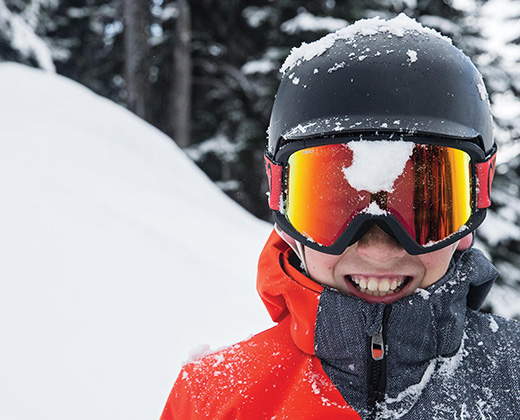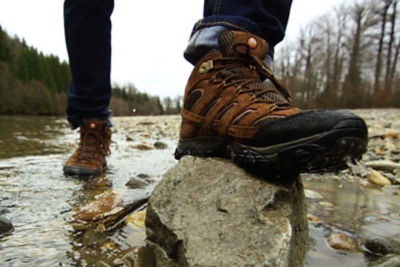How To Buy Snowboard Goggles
Packing up for the mountain? Our experts share their tips for finding the right pair of snowboarding goggles.

It’s simple: when you’re on the slopes, you have to be able to see. Nothing can stand in the way of your run quite like the sun’s glare or cloudy vision. Choosing the right pair of ski and snow goggles is crucial to your experience on the slopes.
Should you go with rose-hued goggles or a futuristic mirrored lens? What frame is right for you? Use this Pro Tips guide to determine which goggles best fit your persona.
COLOR
Each lens color filters light in a particular way. You can choose a color based on the light and weather conditions you’ll likely encounter.
“The right lens color provides crisp vision,” Katie Vernaccini, a snowboarding merchandiser at DICK’S Sporting Goods, says. “It provides better depth perception and a better view of the terrain ahead.”
- Overcast skies: If it’s cloudy, foggy or snowy outside, go for a light lens color. Think yellow, rose, amber, green or blue.
- Sunny skies: In light conditions, turn toward dark lens colors. Try gray, black, brown and dark coppers. Polarized lenses minimize the glare that reflects from snow or ice.
- Nighttime skies: Stick with clear lenses.
- Mirrored lenses: Lenses with a mirror coating reflect a greater amount of light than non-mirrored lenses. They offer excellent clarity in bright conditions. However, they aren’t as effective in low light.
VISIBLE LIGHT TRANSMISSION
Goggles always indicate a Visibility Light Transmission percentage, which is the amount of light that can filter through a lens.
- If you’re riding in overcast, snowy conditions, go for a lens that has a higher percentage of VLT to allow inadequate levels of light. Think 60 percent or more.
- In bright conditions when the sun is reflecting from the snow’s surface, you’ll need ski goggles with a lower VLT percentage to minimize glare.
LENS SHAPE
- Flat lenses – sometimes called cylindrical lenses – are a great choice for novice snowboarders. They curve horizontally to promote peripheral vision but remain flat vertically.
- Spherical lenses curve horizontally and vertically. These lenses are more advanced and minimize visual distortion, glare and fogging. They also offer better peripheral vision.
“Flat lenses are more basic and can provide some limits visually,” Paige Menzel, an outdoor equipment coordinator at DICK’S Sporting Goods, says. “Spherical lenses give you overall better vision, and helmets tend to fit better with the spherical lenses.”
New to snowboarding and skiing? Be sure to familiarize yourself with the two ways you should wear your goggles with this Pro Tips mountain equipment guide.
CAN YOU GET PRESCRIPTION SNOW GOGGLES?
Can’t get your goggles to fit over your glasses? If you use prescription glasses, another option for your goggles is to equip them with custom prescription lenses. The lens will fit securely inside the goggles, almost like another layer to the lens. Prescription goggle lenses are also treated with anti-fog coating.
Prescription goggles are also convenient to save you time from having to stop and adjust your glasses. Enjoy your run on the slopes without having to shift your glasses and take your goggles on and off.
THE RIGHT FIT
When trying on snowboard goggles, bring the helmet or beanie you typically wear on the slopes. Your goggles should be snug but comfortable. Face foam around the lens should feel consistent throughout, and there should be no gaps. To find the right fit, keep in mind these factors:
- Helmet-compatible goggles fit securely without stretching or bending to fit over your headgear.
- OTG goggles – or over-the-glasses goggles – fit comfortably over prescription glasses. These are a much cheaper alternative to custom prescription snow goggles.
- Adjustable straps let you customize the fit of your snowboarding goggles. Wider straps tend to be easier to adjust on the go.
- Snow goggle frames should have a flexible fit.
VENTILATION
More venting equals less fog. It also provides natural airflow for better comfort on the slopes, but there’s a trade-off. That extra venting might make your face colder, particularly in extreme conditions. Always check to see if the venting on your goggles is compatible with the venting on your helmet.
ANTI-FOG
In addition to built-in vents, many snowboarding goggles have an anti-fog coating that prevents moisture build-up on the lens. This feature comes on most mid- to high-end snowboarding goggles. Some goggles come with double-layered lenses that offer an extra barrier against fogging.
Snow goggles are essential tools to help keep your focus solely on your run. Avoid tinkering with your equipment before, during and after your next journey down the mountain with the right pair of goggles.
Snow goggles are a must-have in your bag. Don’t know where to start in packing your snowboarding bag? Pro Tips is here with our guide on how to pack your snowboarding bag to help you get all of your equipment in your bag.







